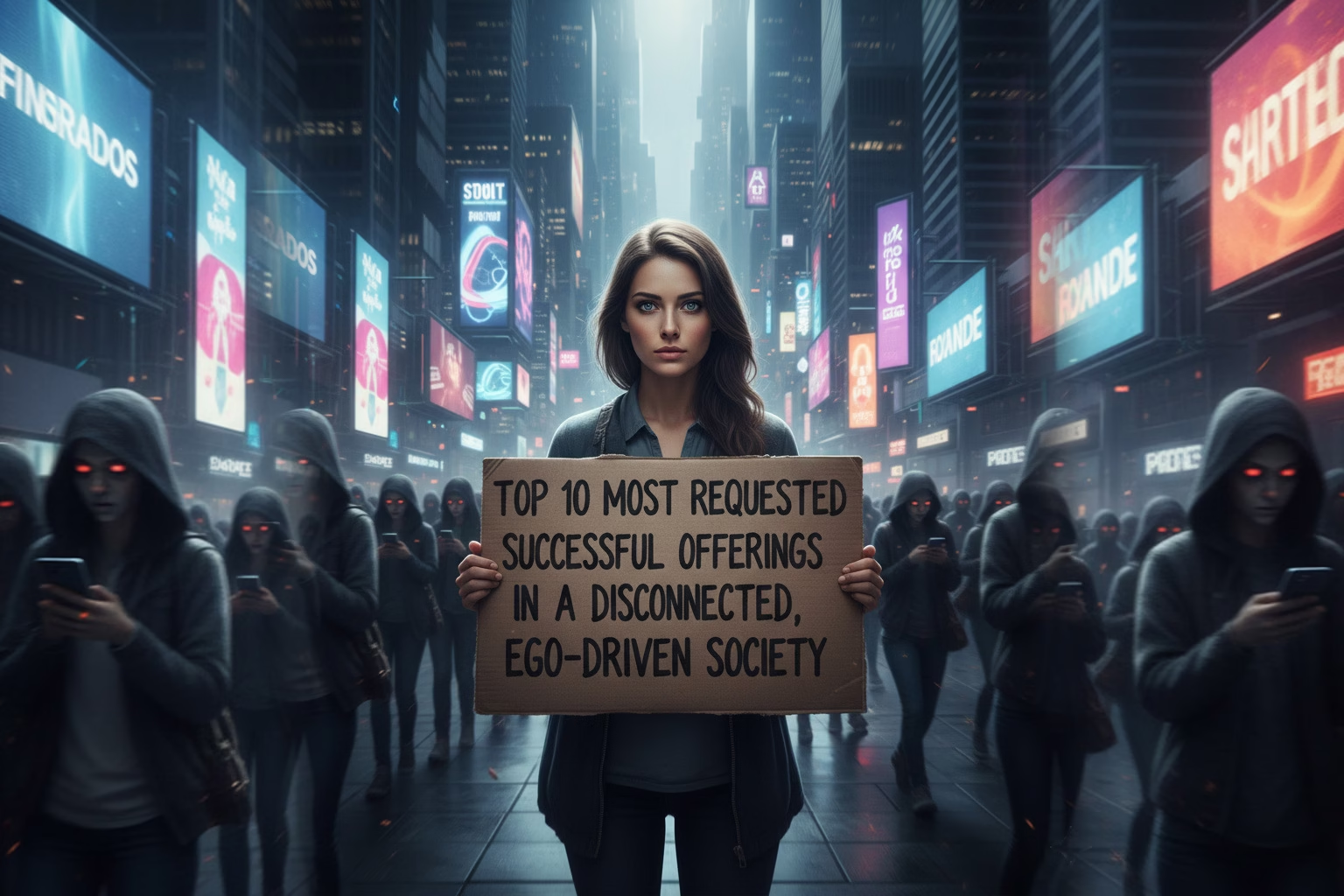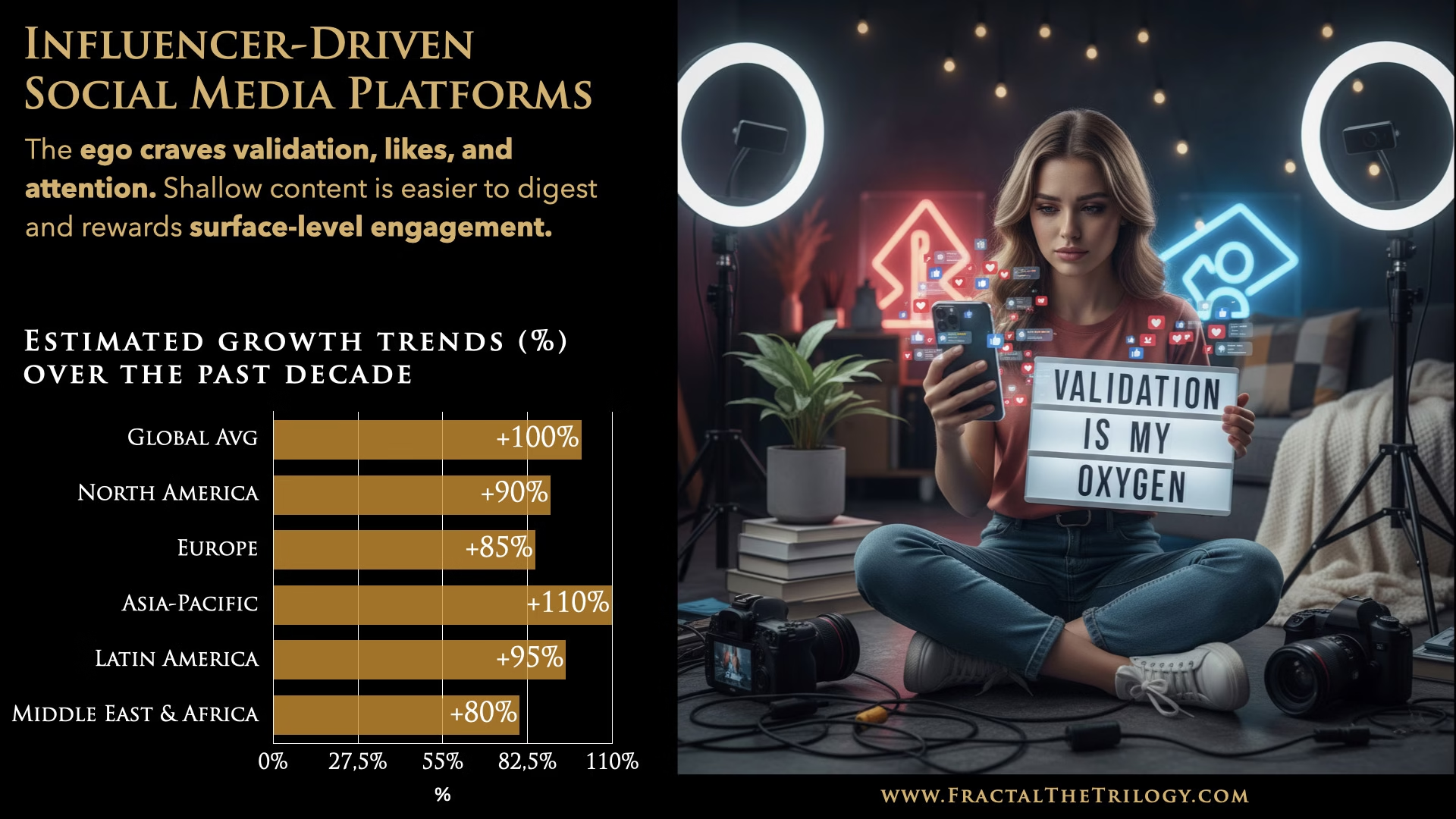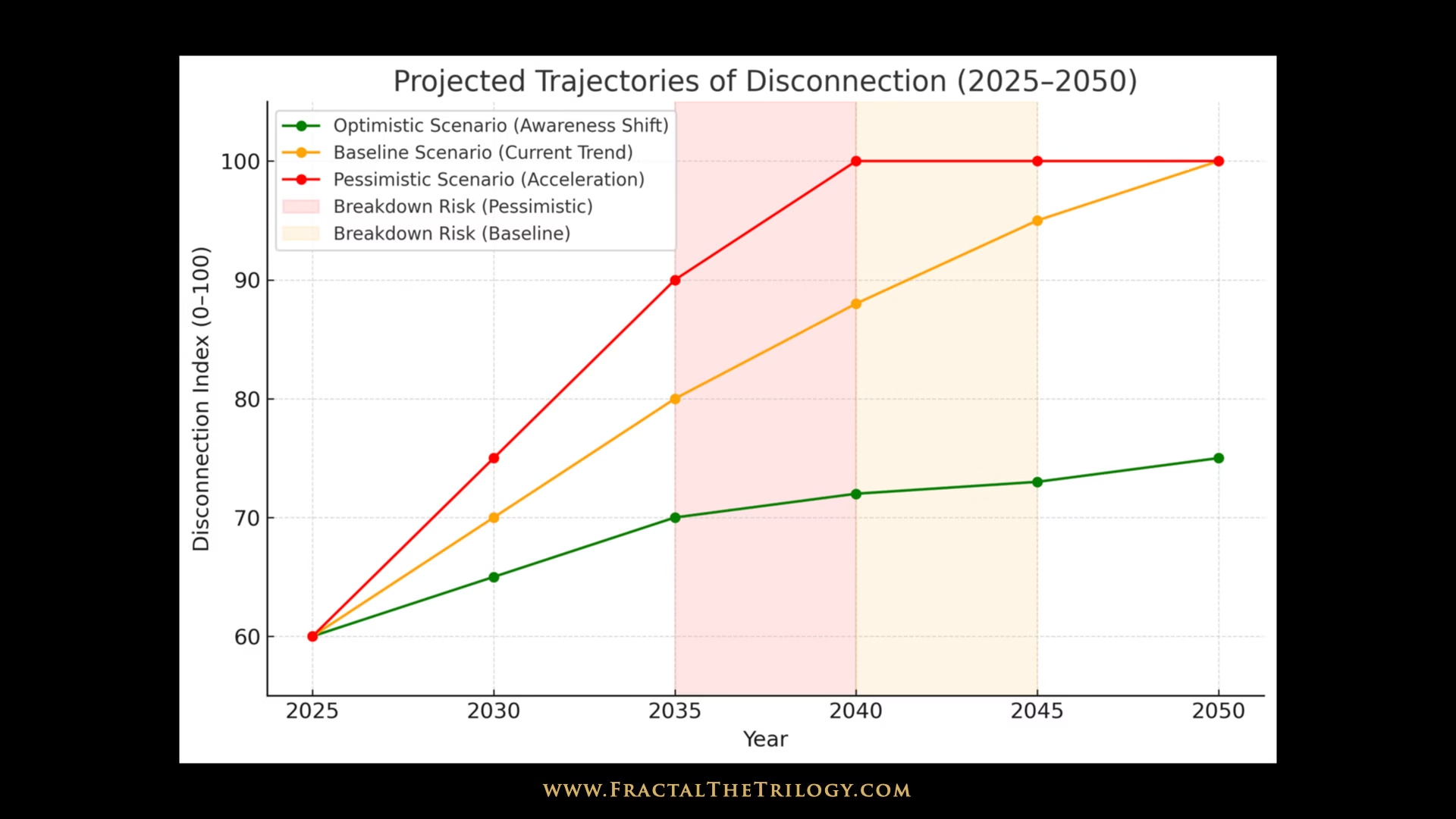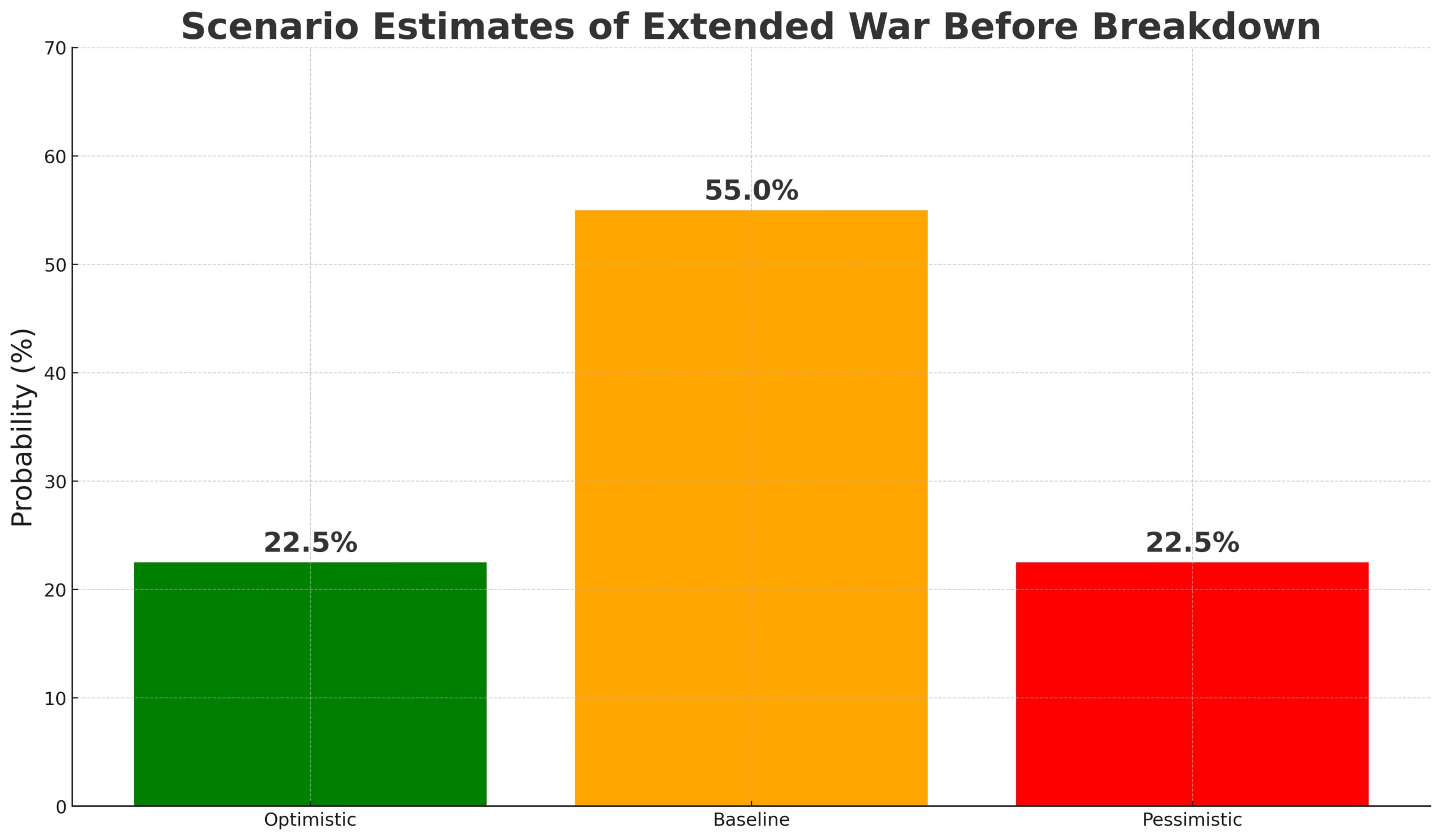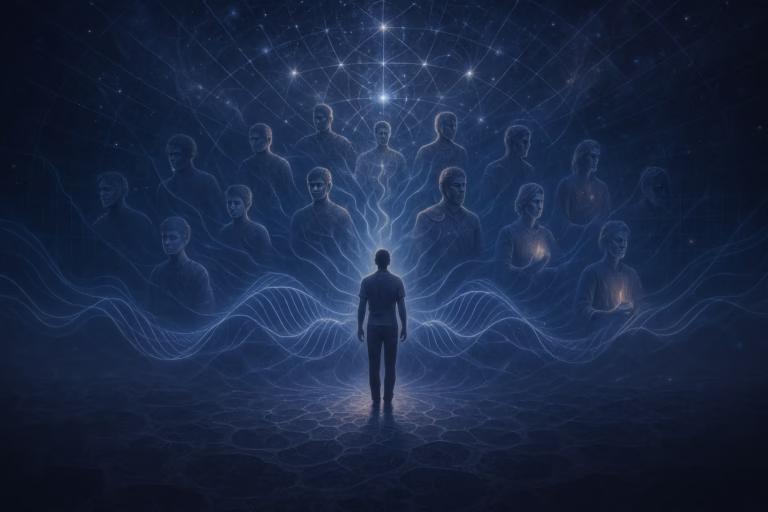PODCAST: When Awareness Fades
Introduction: If the Trend Continues…
After the presentation of my trilogy, I sat in silence for a while—still feeling the echo of the final bell, the energy of the people, the questions left hanging in the air.
And I started thinking about the future.
Not just the distant, science-fiction future of my story…
But the very real, very near future we are all walking into.
What kind of world are we creating, day by day, choice by choice?
I looked around at the trends, the scrolling, the rushing, the craving for more. I noticed how easy it is now to live disconnected from our higher self. To be driven not by awareness, but by ego. Not by meaning, but by appearance.
And then a question struck me:
If this trend continues… what kind of products, services, and experiences will become the most successful?
What does the market look like in a society where people are less aware, more reactive, more hungry for shortcuts and validation?
So I followed the thread. And what emerged was not a judgment, but a map.
A map of the world we’re unconsciously building when awareness fades.
Let’s explore it together: the Top 10 things that thrive in a disconnected society, and what they reveal about where we’re heading… and how we can choose differently.
1. Fast Fashion & Consumer Trends
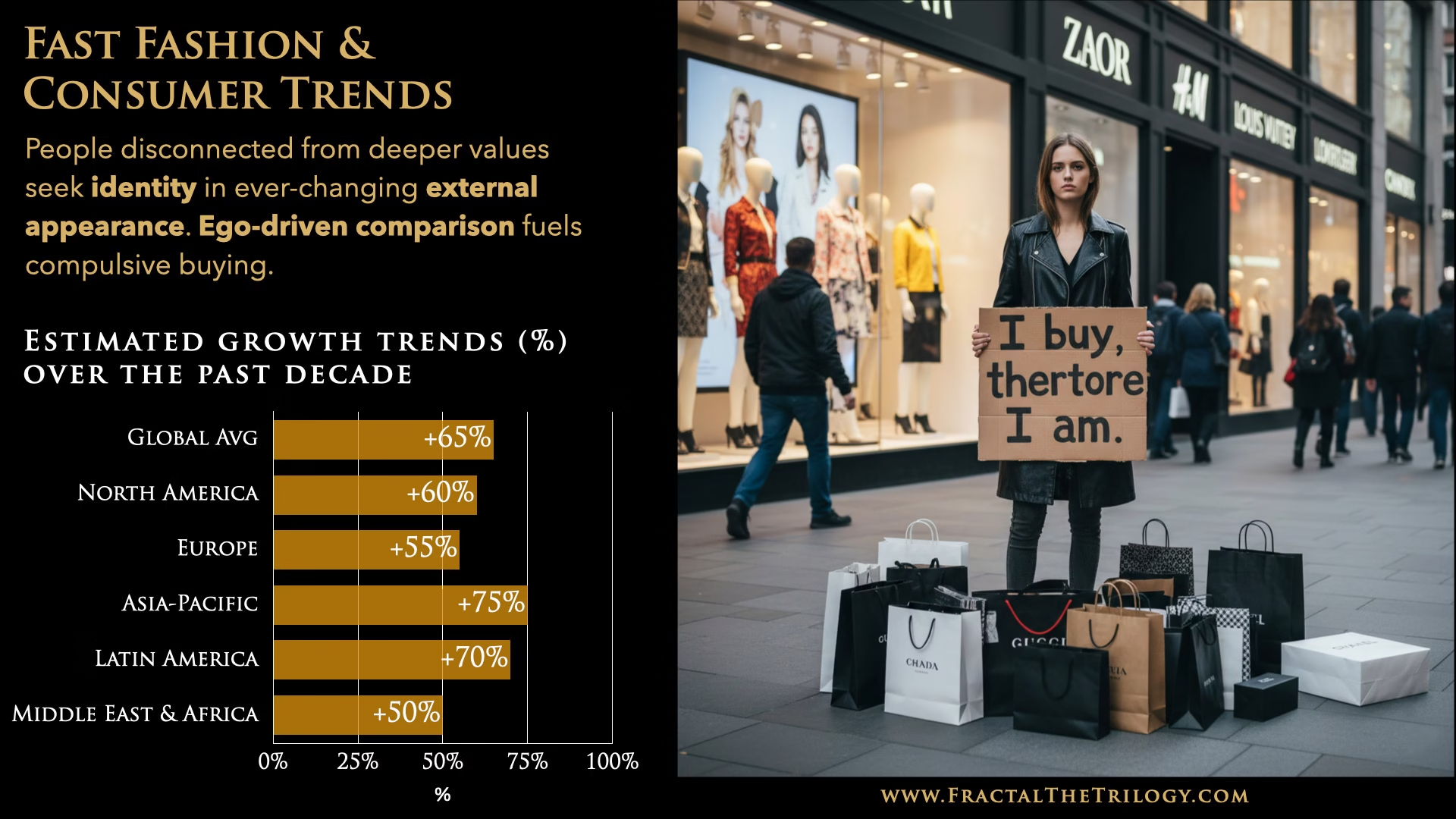
Why it thrives:
In a world where people feel disconnected from their deeper identity, they often seek it externally—especially through what they wear. Fashion becomes more than clothing; it turns into a quick way to say, “This is who I am.”
Fast fashion brands feed this need by offering cheap, trendy clothes that change every week. The ego loves novelty—it constantly craves something “new” to feel alive. So people buy more and more, not out of necessity, but to fill a sense of emptiness or to keep up with others.
The result? A cycle of short-lived satisfaction, overflowing closets, and a growing environmental crisis.
It’s not about style—it’s about seeking identity through stuff.
The quantitative trend
Ten years ago, a new outfit was something special. Today, it’s disposable.
In just over a decade, the fast fashion market nearly tripled — from around $35 billion in 2010 to more than $100 billion in 2025. Clothes are produced at a dizzying pace: the world now makes twice as many garments as 15 years ago, while the average person buys 60% more pieces but wears them for only half as long.
Shein, once a little-known online shop, now sells over $30 billion a year — proof that endless novelty has become the business model. Zara and H&M churn out new collections weekly, training us to crave the next thing before the last one has even been worn.
Region by region, the story is the same:
- In Asia-Pacific, the growth is explosive (+75% in a decade), as production hubs became consumption giants.
- In North America and Europe, people already consumed heavily, but demand still grew by 50–60%.
- Latin America, the Middle East, and Africa are catching up fast, with wardrobes filling at record speed.
The numbers tell us this isn’t about clothing anymore — it’s about identity. When people feel less connected within, they search for belonging in what they wear. Fast fashion has become the perfect mirror of disconnection: cheap, constant, and never enough.
2. Influencer-Driven Social Media Platforms
Why it thrives:
When people feel disconnected from their inner self, they start looking for worth in the eyes of others. Social media becomes the perfect stage where the ego can perform—seeking likes, comments, and followers as a substitute for true connection.
Influencers, often shaped by carefully curated images and highlight reels, become modern idols. They seem to “have it all,” and millions try to imitate them—not realizing that much of what they see is filtered, staged, or sponsored.
This constant comparison makes people feel “not enough,” so they spend more time scrolling, posting, and chasing approval. Platforms are designed to keep us hooked—not inspired.
In the end, we become content… instead of becoming conscious.
The quantitative trend
Scroll, like, post, repeat. In a single decade, social media transformed from a pastime into the world’s biggest stage for ego. Back in 2015, there were about 2.3 billion social media users. By 2025, that number has more than doubled to over 5.4 billion — two out of every three people on Earth. And the average user now spends more than 2 hours a day scrolling, posting, and comparing.
In the United States and Europe, adoption is nearly saturated — almost everyone with internet access is on at least one platform. In Asia-Pacific, the numbers are staggering: close to 3 billion users, making it the beating heart of global social media. Even Latin America, the Middle East, and Africa — once lagging — have seen adoption climb by 60–80% in a decade as smartphones spread.
Influencers are the new celebrities, and validation is the new currency. Platforms built to connect us now profit from keeping us hooked — from amplifying envy, comparison, and the constant chase for attention.
The money trail is clear: advertising revenues, influencer sponsorships, and platform profits have exploded, riding on a simple truth — the more disconnected we feel inside, the more we seek recognition outside.
3. Ultra-Processed Food & Instant Delivery
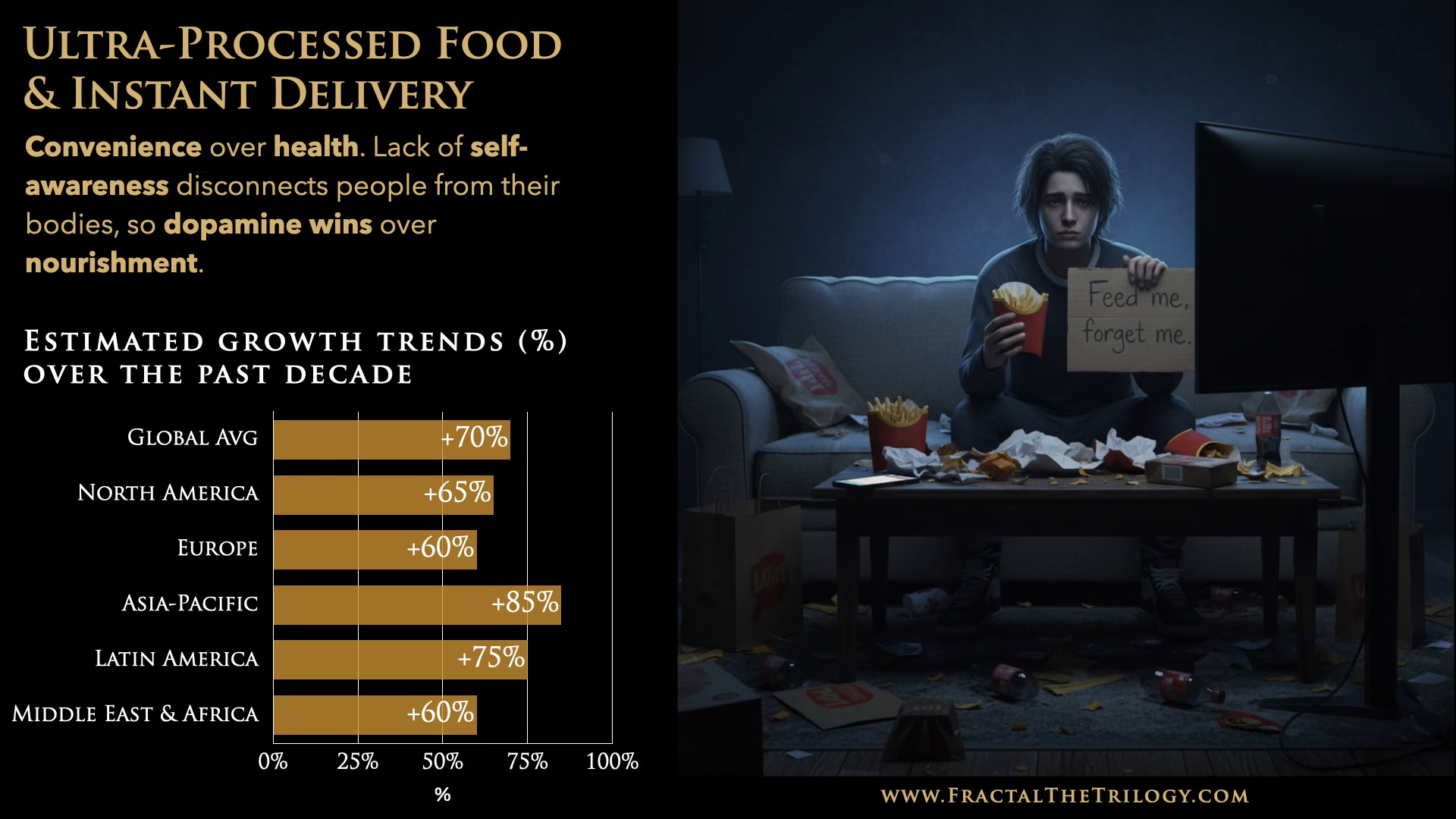
Why it thrives:
When we lose touch with our bodies and inner rhythms, we start eating to fill emotional gaps, not to nourish ourselves. The ego wants quick pleasure, not long-term well-being. That’s why ultra-processed foods—loaded with sugar, salt, and fat—are everywhere.
They’re fast, cheap, addictive, and available 24/7 with just a tap. Cooking becomes rare. Waiting becomes annoying. We don’t ask, “What does my body need?” but rather, “What’s fast and makes me feel good now?”
Food delivery apps explode because they promise instant satisfaction with zero effort. But the cost is high: poor health, fatigue, brain fog, and a deeper disconnect from what truly sustains us.
In the end, we consume to feel full—but stay deeply empty.
The quantitative trend
Dinner used to mean time, preparation, even ritual. Today, for millions, it means tapping a screen. In the last decade, the global ultra-processed food and delivery market has exploded. Food delivery alone has more than doubled since 2017, reaching a value of around $150 billion in 2024, with annual growth near 10%.
Consumption habits tell the same story: people eat 60–70% more processed snacks and ready meals than they did a generation ago. Ultra-processed products now make up over half of daily calories in many Western countries.
Region by region, the trend is relentless:
- In North America and Europe, convenience dominates — delivery grew +65% in a decade, while processed food has become the norm.
- Asia-Pacific surged even faster (+85%), with super-apps like Meituan and Grab normalizing on-demand meals.
- Latin America, the Middle East, and Africa followed, growing 60–75% as urban lifestyles shifted and smartphones spread.
The kitchen has slowly become less of a gathering space, and more of a storage room for takeout boxes. What the money shows us is simple: when awareness drops, we feed not our bodies but our cravings. Fast food, faster delivery — hunger satisfied instantly, but emptiness often lingers.
4. Pornography & Casual Hookup Apps
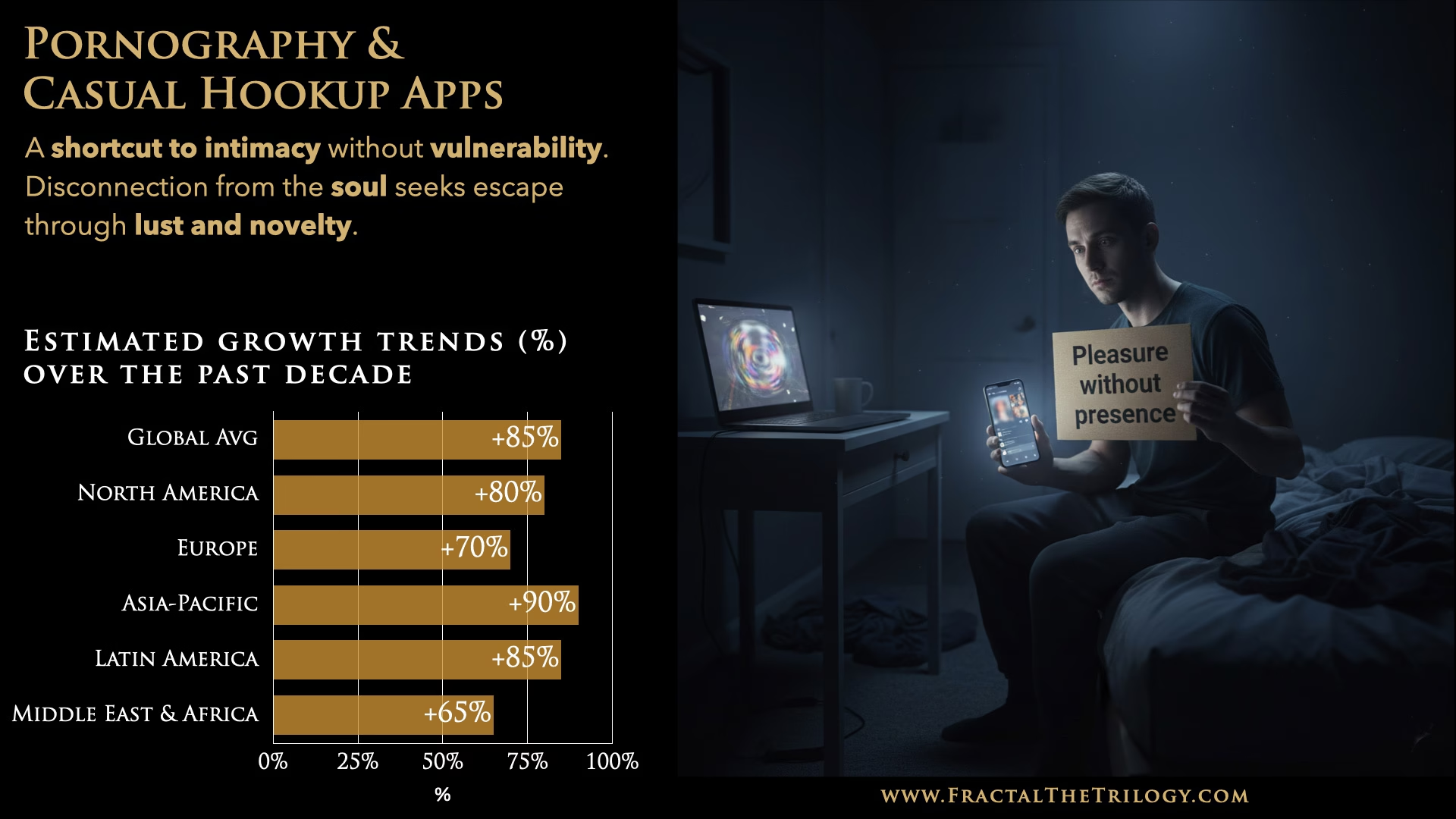
Why it thrives:
In a disconnected society, real intimacy—emotional, spiritual, vulnerable—feels too risky or too slow. So people turn to instant, surface-level pleasure to avoid loneliness or emotional pain.
Pornography and hookup apps offer the illusion of connection without the complexity of real relationship. They’re quick, easy, and offer dopamine on demand. But they reduce human intimacy to pixels or swipes, stripping away depth and meaning.
The ego seeks control and satisfaction without commitment. These platforms deliver that perfectly—yet leave behind a growing sense of emptiness, disconnection, and even addiction.
What begins as a private escape can slowly replace our ability to truly relate, love, or be present with another human being.
The quantitative trend
Intimacy used to be something fragile, built slowly. Today, it can be summoned in seconds. Over the last decade, pornography and hookup apps have surged to record highs.
In 2019, Pornhub alone logged 42 billion visits in a single year — that’s 115 million clicks every day, and nearly 9 billion more than the year before. By the mid-2020s, adult sites consistently rank among the most visited on the internet, surpassing even platforms like Netflix or Amazon.
Dating apps tell the same story: global revenues grew from about $3 billion in the mid-2010s to over $6 billion in 2024. Hundreds of millions of people now swipe daily. In the U.S. and Europe, one in three new couples meet online. In Asia-Pacific, growth is even faster (+90%), with apps like Tantan in China or BharatMatrimony in India reshaping relationships.
Everywhere, the numbers rise:
- North America & Europe: +70–80% growth in a decade, normalized usage.
- Asia-Pacific: explosive (+90%), billions of swipes daily.
- Latin America, Middle East, Africa: adoption climbing steadily (+65%).
These platforms promise connection, but often deliver simulation without depth — pleasure without presence, companionship without commitment. The money shows us what the heart may not want to admit: when we disconnect inside, we search for intimacy in pixels and swipes, faster and faster, but rarely fulfilled.
5. Celebrity Culture & Toxic Fame Obsession
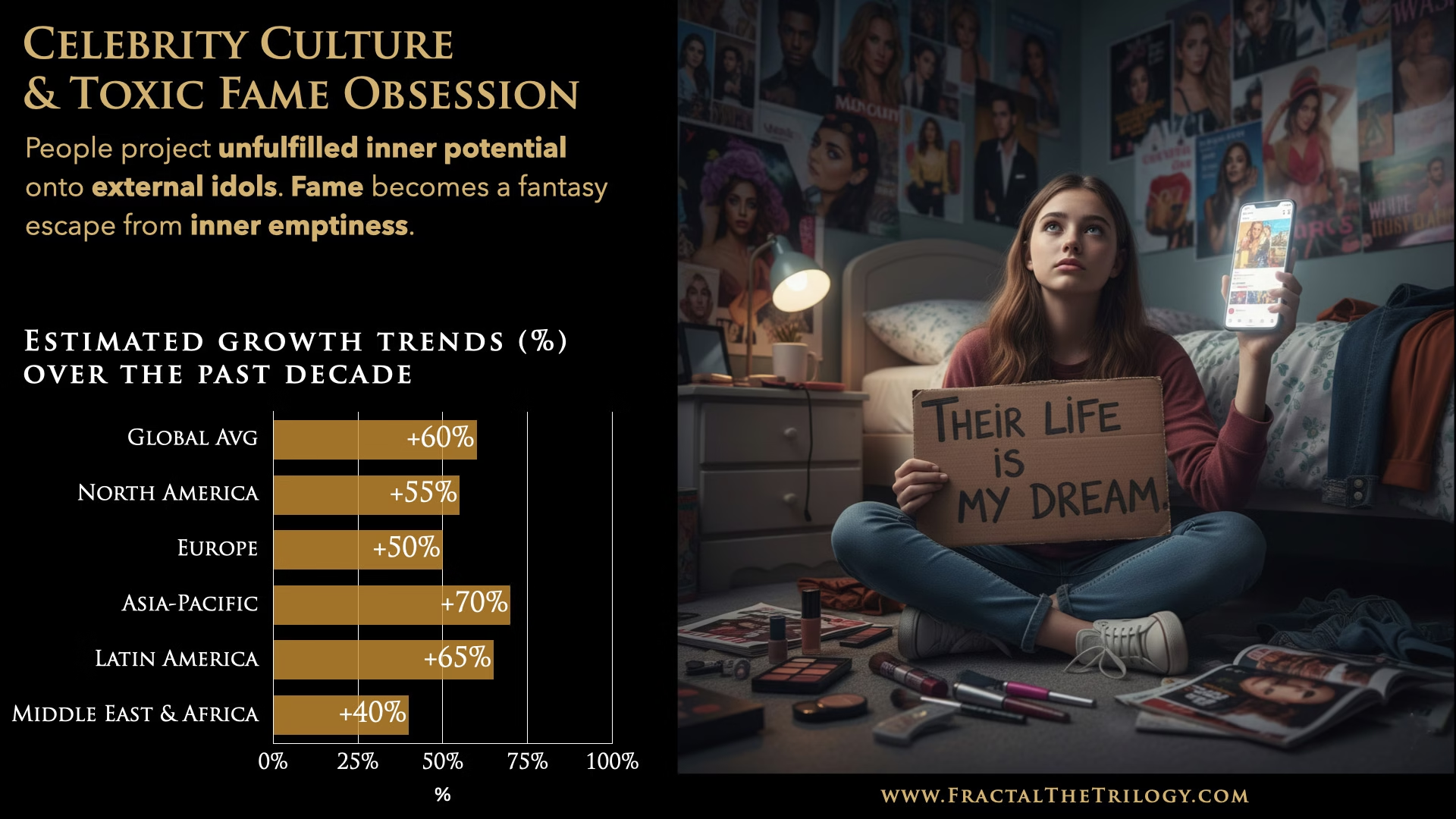
Why it thrives:
When we feel unfulfilled or unseen in our own lives, we start living through others—especially those who appear to “have it all.” Celebrities and influencers become symbols of a perfect life, and our ego projects dreams and desires onto them.
This obsession isn’t just about admiration—it’s about escape. Their fame gives us a fantasy: “If I had their life, I’d finally be happy.” We follow every move, every scandal, every outfit—while often ignoring our own growth or potential.
Media companies and algorithms amplify this dynamic because it sells attention. But the more we idolize others, the more we disconnect from our own worth, voice, and purpose.
We become spectators in the theater of fame—instead of authors of our own story.
The quantitative trend
Once, fame was rare — the privilege of a few. Now, it’s everywhere, and its reach has multiplied. Over the past decade, the business of celebrity culture has only grown stronger, fueled by social media, reality shows, and influencer marketing.
Global media and advertising tied to celebrities and influencers has ballooned — influencer marketing alone expanded from under $2 billion in 2016 to over $20 billion in 2025, a tenfold increase. Streaming platforms and tabloids thrive on gossip, with entire ecosystems dedicated to keeping eyes fixed on the famous.
Regionally, the trend is universal:
- North America and Europe: steady growth (+50–55%) as Hollywood, music, and sports celebrities remain central cultural exports.
- Asia-Pacific: rapid rise (+70%), with K-pop, Bollywood, and Chinese social stars dominating global youth culture.
- Latin America, Middle East, Africa: strong growth (+40–65%), local celebrities amplified by global platforms.
The numbers prove it: we spend billions not just to consume art or sport, but to follow the personal lives of the people who perform them. The business thrives because our gaze has shifted outward — toward icons to worship, copy, and envy. Fame is no longer about talent alone; it’s about the spectacle of lifestyle. And the more disconnected we are from our own worth, the more magnetic the lives of others become.
6. Luxury Status Symbols (Cars, Watches, Designer Goods)
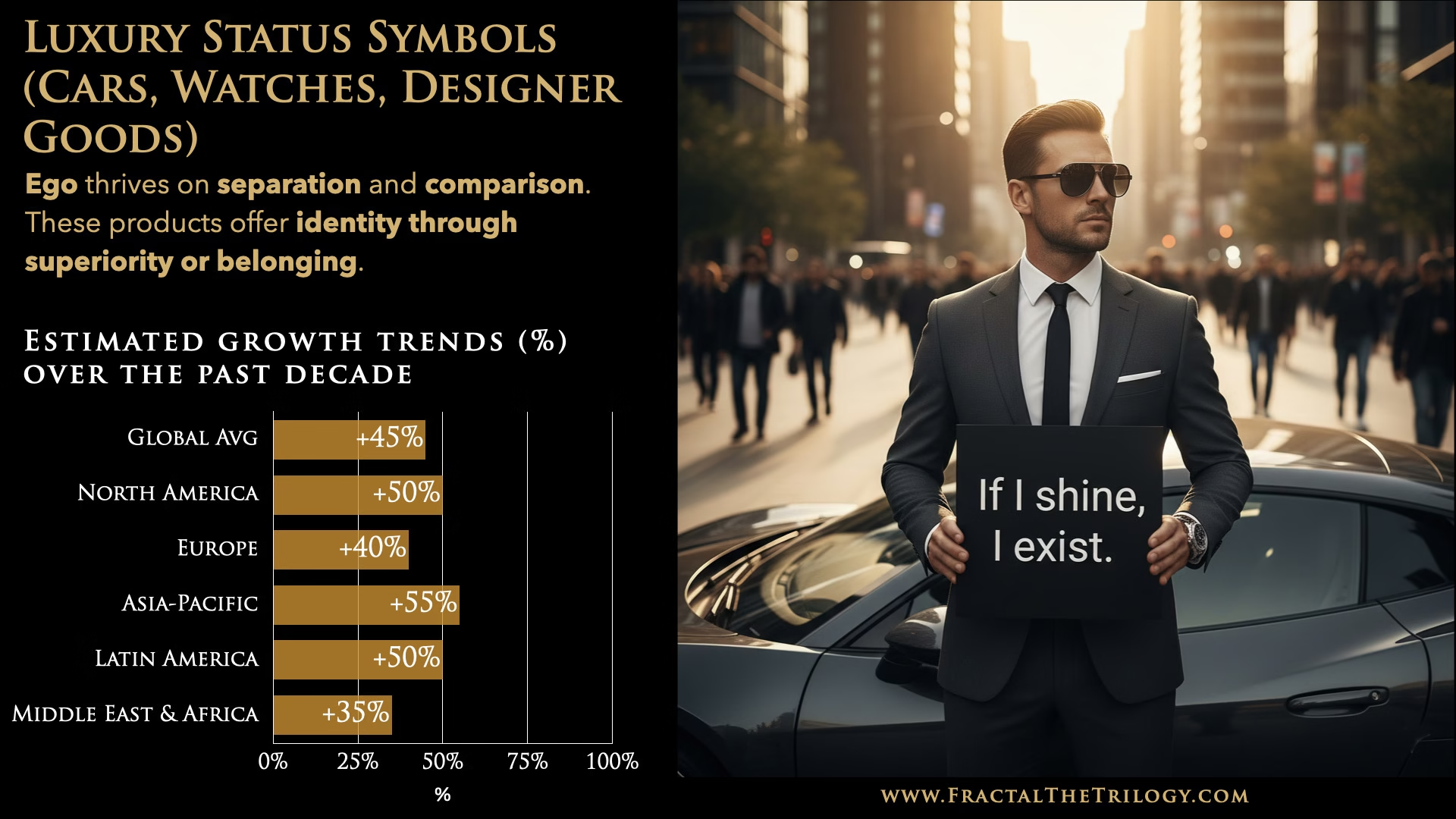
Why it thrives:
In a world driven by comparison, owning becomes a way of being. When the connection to inner value fades, the ego looks for validation through what we own instead of who we are.
Luxury goods—cars, designer brands, expensive gadgets—become symbols of success and superiority. They don’t just say “I have money”—they say “I matter.” And in a society where image often counts more than substance, that message sells.
People go into debt to keep up appearances. Social media turns luxury into performance. But behind the polished surface, many still feel unseen, insecure, and disconnected.
These symbols shine on the outside—but rarely heal what’s missing on the inside.
The quantitative trend
A decade ago, luxury was a niche. Today, it’s a booming global industry. From handbags to supercars, the market for status symbols has surged by nearly 50% in ten years, reaching over $370 billion in 2025.
Luxury car sales climbed steadily, with brands like Ferrari and Lamborghini reporting record revenues year after year. Designer fashion houses such as Louis Vuitton, Gucci, and Dior became trillion-dollar cultural engines, with double-digit growth especially in the last five years. Even watches — once seen as relics of a pre-digital age — are thriving, with Rolex and Patek Philippe having waitlists that stretch for years.
By region:
- Asia-Pacific: leads the growth (+55%), as China and Southeast Asia became the largest luxury consumer markets.
- North America & Europe: steady +40–50%, where luxury brands remain cultural anchors.
- Latin America, Middle East, Africa: rising +35–50%, especially in wealthy urban centers like Dubai, São Paulo, and Johannesburg.
The message behind the numbers is clear: luxury has become less about craft and more about identity projection. People buy to be seen, not just to own. When inner worth feels shaky, a logo or a shiny car becomes the armor of ego. The business thrives because status has become a shortcut for meaning.
7. Over-the-Counter “Fixes” (Supplements, Cosmetic Procedures, Biohacks)
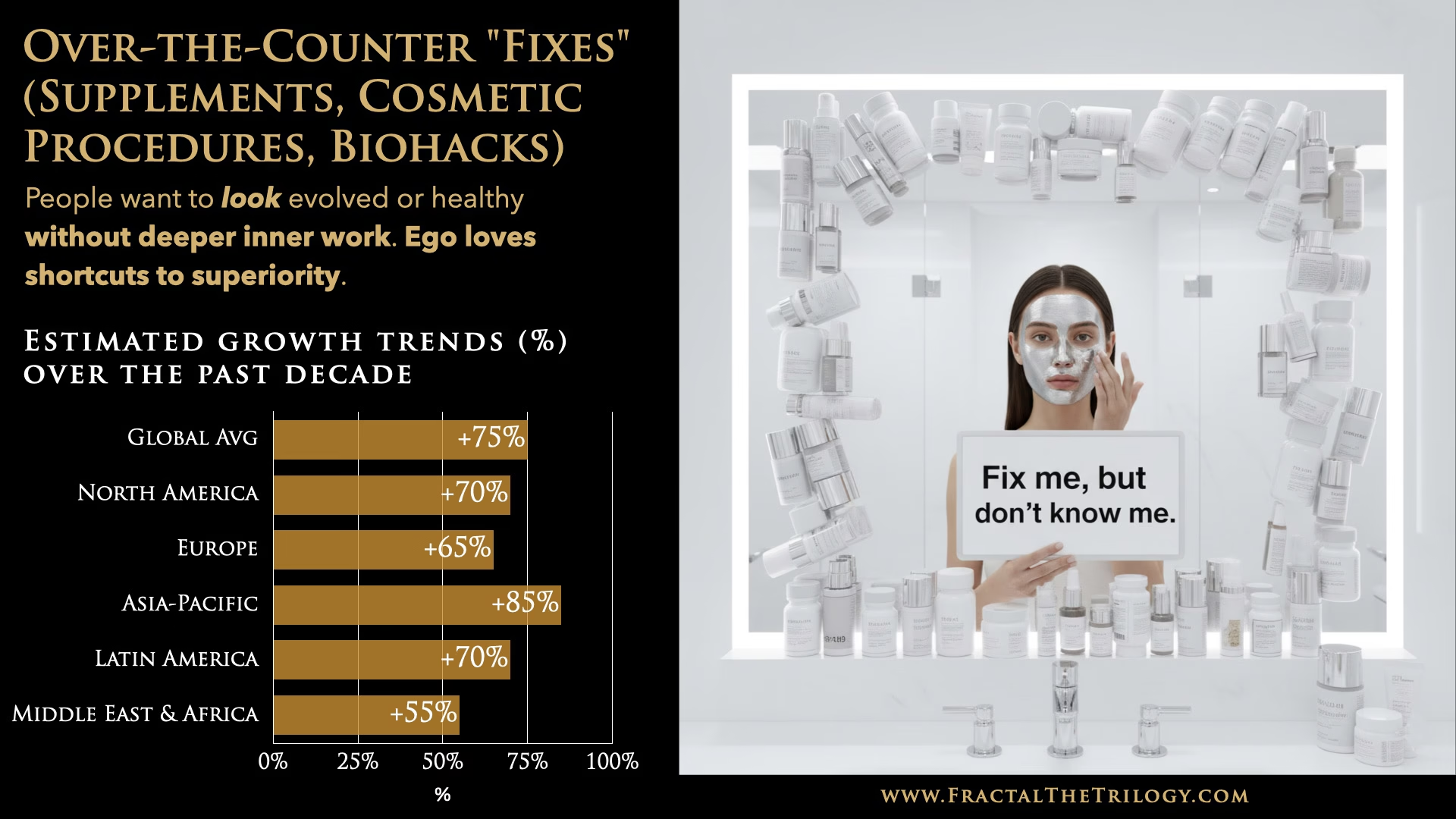
Why it thrives:
When people feel disconnected from their inner selves, they often chase perfection on the outside. The ego says: “You’re not enough—yet. But you could be… with a little fix.”
So a massive market emerges: pills for energy, creams for youth, surgeries for beauty, hacks for performance. People search for shortcuts to feel better, look better, be better—without addressing the root cause: lack of self-acceptance and inner balance.
These solutions aren’t inherently wrong—but they become harmful when used to cover up emotional wounds or avoid inner work. The promise of instant transformation keeps people spending… but rarely healing.
We try to “optimize” ourselves like machines—forgetting we’re already whole as humans.
The quantitative trend
Ten years ago, self-improvement meant patience — healthy habits, long-term care. Today, it often means a shortcut. The market for supplements, cosmetic procedures, and quick fixes has skyrocketed, growing by roughly 70–80% over the last decade.
Nutritional supplements alone became a $170+ billion global market in 2025, almost double what it was in 2015. Cosmetic surgery and non-invasive procedures (like Botox or fillers) have seen similar booms: in the U.S., minimally invasive treatments jumped by over 40% since 2015, while countries like South Korea turned “beauty optimization” into a cultural norm.
By region:
- Asia-Pacific: the fastest growth (+85%), with South Korea, China, and Japan leading in cosmetic procedures and supplement consumption.
- North America & Europe: strong demand (+65–70%), dominated by wellness products and elective beauty treatments.
- Latin America, Middle East, Africa: rising (+55%), with Brazil and Dubai becoming global cosmetic surgery hubs.
The numbers show us something deeper: more people are spending more money not to heal from within, but to fix the surface. Pills for energy, injections for youth, powders for performance — the ego is hungry for quick transformation. These industries thrive on insecurity, promising confidence in a bottle or a needle, while the real work of self-acceptance waits unseen.
8. Hyperviolent or Escapist Entertainment (Shooter Games, Action Films)
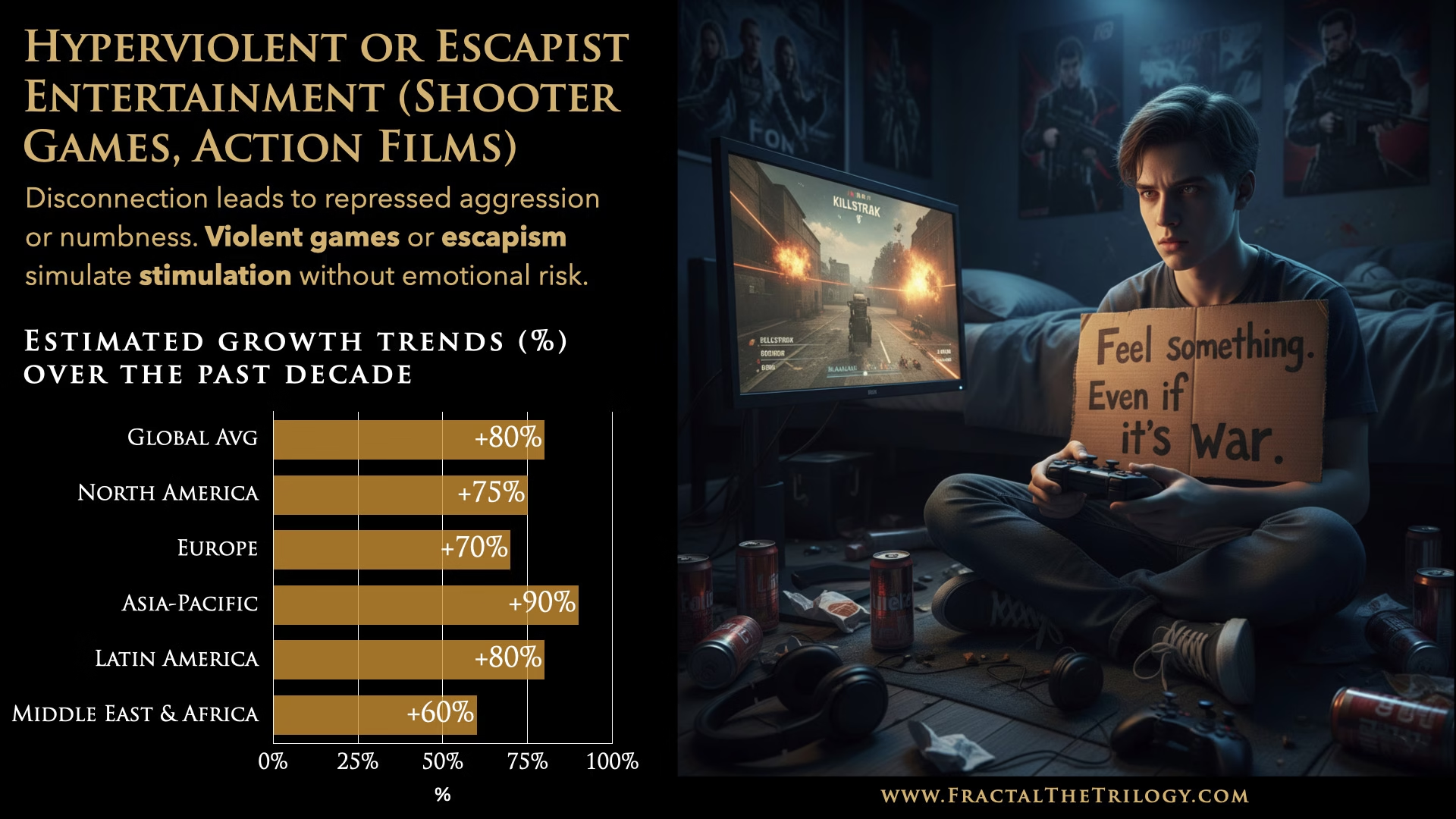
Why it thrives:
When reality feels overwhelming or meaningless, people crave escape. And the ego, feeling powerless or numb, often seeks stimulation—something loud, intense, or extreme just to feel something.
That’s why hyperviolent video games and action-packed entertainment are booming. They offer a space where control, power, and adrenaline are guaranteed. Unlike real life, there’s no emotional complexity—just enemies to defeat or explosions to enjoy.
For many, it becomes a release valve for repressed emotions—especially anger, fear, or loneliness. But over time, constant exposure to simulated conflict and violence can dull empathy, increase desensitization, and disconnect people from peace, stillness, and reality itself.
It’s not just escape—it’s emotional avoidance, packaged as fun.
The quantitative trend
What was once a hobby is now an empire. In the last decade, video games and violent escapist media have doubled in scale, with global gaming revenues climbing from around $90 billion in 2015 to nearly $185–190 billion in 2025. The number of gamers worldwide crossed 2.7 billion in 2020, meaning more than one in three humans is now immersed in digital worlds.
The content is louder, faster, more extreme. Shooter games dominate charts, and streaming platforms broadcast battles to millions. E-sports turned into billion-dollar industries, with players idolized like rock stars.
Regionally:
- Asia-Pacific: the powerhouse (+90%), home to over half the world’s gamers, led by China and South Korea.
- North America & Europe: steady +70–75% growth, with gaming now surpassing movies and music combined in revenue.
- Latin America, Middle East, Africa: fast adoption (+60%), fueled by mobile gaming and cheaper access to online play.
The growth is undeniable — and it reveals a hunger not just for entertainment, but for escape. When reality feels heavy, games offer worlds where rules are clear, identities can shift, and victories come fast. But the more immersive they become, the easier it is to replace presence with pixels. The industry thrives because it sells not just play, but an alternate reality.
9. High-Stimulation Experiences (Parties, Festivals, Extreme Sports)
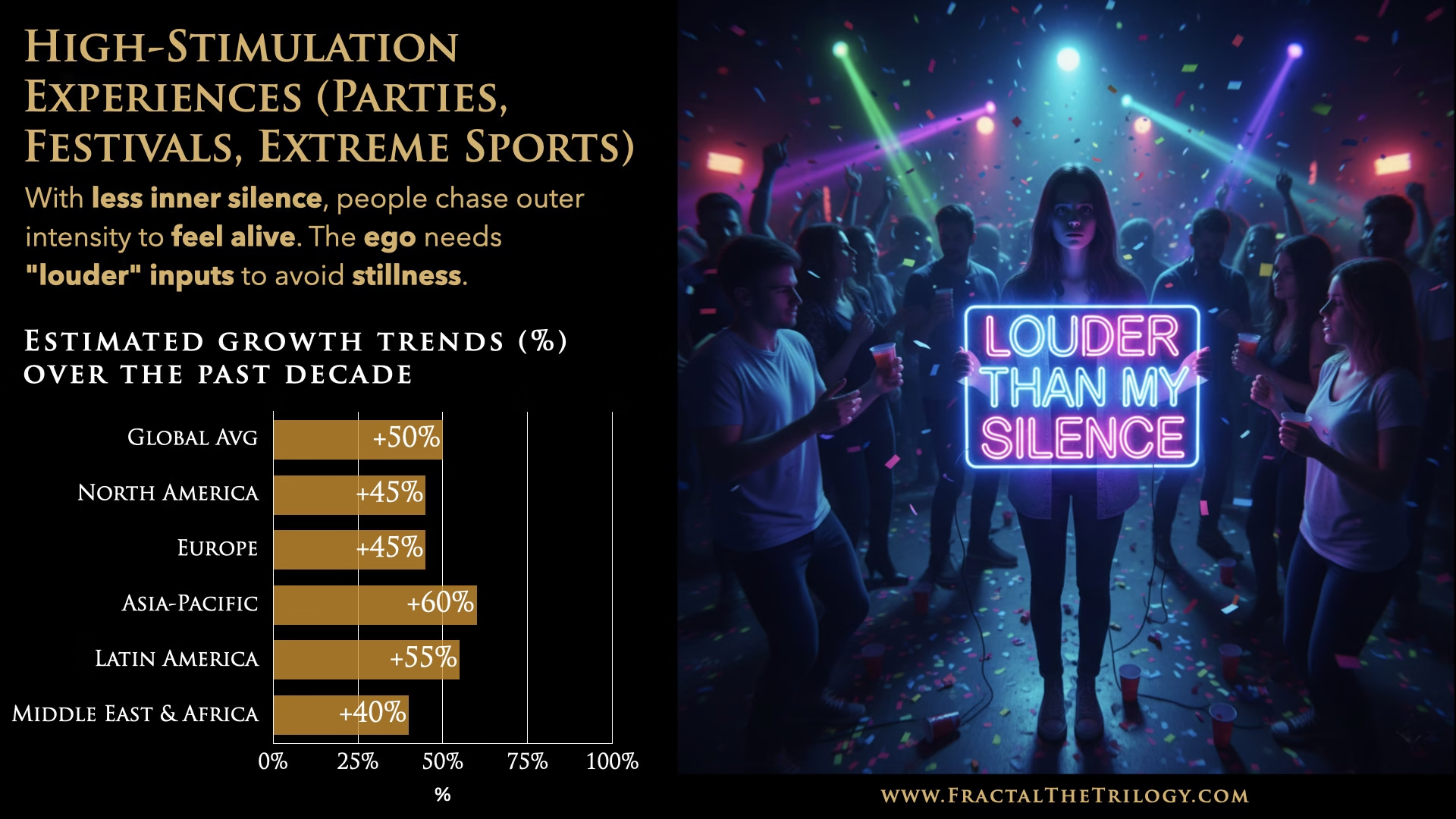
Why it thrives:
In a society disconnected from inner stillness, silence often feels uncomfortable—even frightening. So people chase louder, faster, brighter experiences to distract themselves from the emptiness within.
Parties, festivals, extreme sports, or high-adrenaline events promise a temporary sense of aliveness. The ego loves these environments because they offer a chance to stand out, perform, and feel important—if only for a moment.
But when the noise fades and the lights go out, many are left with a deeper sense of disconnection, because they’ve only fed the surface—not the soul.
There’s nothing wrong with excitement—but when it becomes a substitute for meaning, it becomes an addiction to stimulation.
The quantitative trend
In a world where silence feels unbearable, noise has become a business. Over the last decade, the global live events and high-stimulation experience market has surged by around 50%, reaching nearly $1.5 trillion by 2025 when including festivals, nightlife, and live entertainment. Music festivals alone have multiplied, drawing crowds of hundreds of thousands — Coachella, Tomorrowland, Burning Man, Ultra — all reporting record attendance year after year.
Extreme sports followed the same arc: adventure tourism, skydiving, bungee jumping, and high-adrenaline travel experiences grew by 60–70% in demand, as people sought ever-stronger doses of intensity.
By region:
- North America & Europe: mature markets, but still +45–50% growth in live events and festivals.
- Asia-Pacific: fastest growth (+60%), with mega-festivals in Japan, South Korea, China, and India drawing millions.
- Latin America, Middle East, Africa: strong rise (+40–55%), with Brazil, Dubai, and South Africa emerging as global party and adventure hubs.
The numbers reveal it clearly: the louder and brighter the world becomes, the more tickets we buy. High-stimulation industries thrive not because we are more alive, but because many of us are afraid of stillness. The marketplace feeds that fear — offering endless distraction from the quiet voice within.
10. Coaching for External Success Only (Wealth, Dating, Confidence)
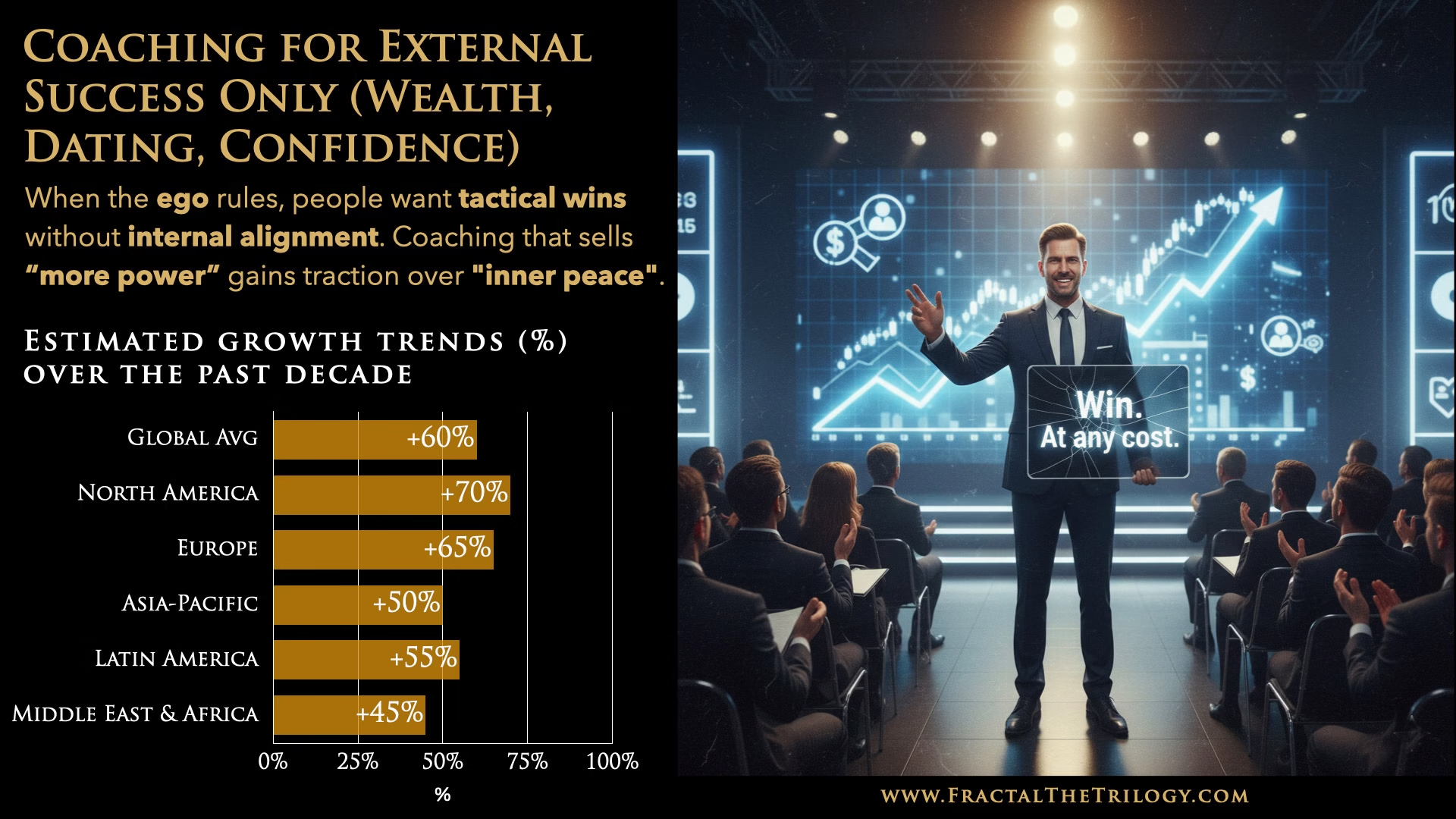
Why it thrives:
As people drift further from their inner truth, many turn to coaching—not for awakening or wisdom—but to win the external game: more money, more dates, more influence.
This kind of success coaching promises quick confidence, power, and strategy. It often speaks to the ego’s deepest fears: “You’re not enough unless you dominate, attract, or outperform.” It sells certainty in a world full of uncertainty.
But when coaching focuses only on external metrics, it can fuel comparison, pride, and illusion. Without inner awareness, it builds stronger masks—not stronger selves.
True coaching should be about becoming, not just achieving. About aligning outer success with inner truth.
The quantitative trend
Coaching was once about growth of the whole person — awareness, purpose, resilience. But in the last decade, a booming niche has emerged: coaching that promises external success only. Wealth programs, dating bootcamps, confidence hacks — industries that tell the ego, “win, and you’ll be worthy.”
Globally, the coaching market has grown from about $2.5 billion in 2015 to over $4.5–5 billion in 2025, with the fastest growth in niches tied to money, influence, and attraction. Courses promising quick confidence or financial mastery have multiplied online, often priced in the thousands, feeding an industry of digital gurus.
By region:
- North America & Europe: steady +65–70% growth, home to the largest concentration of success-driven coaching businesses.
- Asia-Pacific: strong rise (+50%), with wealth and dating coaching expanding in China and India’s middle classes.
- Latin America, Middle East, Africa: moderate but growing (+45–55%), fueled by social media visibility and aspirational marketing.
The money shows us what people are seeking: not inner clarity, but outer dominance. When disconnection grows, the hunger for shortcuts to power, wealth, and attraction intensifies. And so the coaching industry thrives — not always by guiding people home to themselves, but by selling new masks for the ego to wear.
The Breakdown
But by looking at the data you’ve gathered on disconnection, and comparing it with other global risk assessments, we can create a reasoned scenario-based estimate rather than a prediction.
1. The Signs of Acceleration
The 10 sectors we analyzed — social media, fast fashion, processed food, luxury, violent gaming, etc. — are not slowing down. Most are growing 10–20% annually, some even faster. If those growth rates persist:
- Within 10 years (by 2035): more than 80% of the planet will be in these cycles of disconnection.
- Within 20 years (by 2045): awareness-based practices may become minority behaviors unless a counter-trend emerges.
2. What “Breakdown” Means
Breakdown doesn’t always mean collapse of civilization in one dramatic moment. It often shows up as:
- Mental health breakdown: WHO already declared depression and anxiety as leading causes of disability; exponential increases suggest a crisis in the next 5–10 years if not addressed.
- Social fabric breakdown: loneliness epidemics, declining family/community structures → visible in 10–15 years with rising unrest, alienation, polarization.
- Environmental and economic strain: fast fashion, processed foods, over-consumption feed ecological collapse. Scientists warn that humanity may cross irreversible climate and biodiversity tipping points within 20–30 years.
- Spiritual breakdown: loss of meaning, addiction to stimulation, collapse of trust — already evident, and worsening each year.
3. Scenarios
- Optimistic scenario: Humanity recognizes the warning signs and turns toward awareness movements, sustainable practices, and collective healing. Disconnection plateaus by the 2030s. Breakdown is avoided.
- Baseline scenario: Trends continue unchecked. By the early 2040s, breakdown manifests as overlapping crises — mental health, social unrest, and ecological limits colliding.
- Pessimistic scenario: Acceleration + new destabilizers (AI misuse, geopolitical collapse). Breakdown could appear within 10–15 years (by the late 2030s).
4. The Key Insight
If we strictly “follow the money,” humanity is on a trajectory toward increasing disconnection — and systems can’t infinitely grow on emptiness. Left unchecked, the data suggests a critical breakdown point within one to two decades (2035–2045).
5. The Hope
But here is the paradox:
Breakdown is not destiny.
Awareness is the antidote.
The same way disconnection spreads through habits, culture, and economics — connection can spread too. If enough people choose presence, intention, and collective action, the trajectory bends.
Conclusion: The Mirror and the Choice
What we’ve just explored is more than a list of trends.
It’s a mirror—showing us what grows when consciousness sleeps.
Each product, service, or activity isn’t the problem itself…
They’re symptoms of something deeper:
A society drifting away from its center.
Individuals forgetting who they really are.
But here’s the good news: trends are not destiny.
Every system, every market, every culture is made of people.
And that means every shift begins within—quietly, personally, powerfully.
So what can we do?
- Reconnect with stillness, even five minutes a day.
- Question our cravings. Ask: “Am I filling a void or feeding my soul?”
- Choose depth over speed.
- Seek real connection over curated images.
- Support creators, coaches, and businesses that align with awareness—not just profit.
- And most of all, remember:
The most revolutionary act in a distracted world is to be fully present.
This is not a call to reject society—it’s a call to reshape it.
From within.
Because when we awaken—even a little—we don’t just change our choices.
We change the trend.
The Link Between Disconnection and War
History shows that when societies become:
More fragmented (less shared meaning, more ego-driven),
More unequal (wealth concentrated, masses distracted with “bread and circuses”),
More stressed (ecological limits, food, water, energy),
…the probability of large-scale conflict rises.
Disconnection breeds polarization. Polarization breeds mistrust. And mistrust, under pressure, often ignites into war.
Probability Drivers Today
Geopolitical Tensions Already Rising
US–China rivalry, Russia–NATO confrontation, Middle East instability.
Arms spending is at its highest level since WWII (over $2.4 trillion in 2023).
Resource Pressures
Climate change intensifies drought, food shortages, and migration.
Scarcity historically fuels wars (water in Africa, energy in the Middle East, rare earths now in focus).
Technology Acceleration
AI, cyberwarfare, autonomous weapons: new domains of conflict.
Disconnection makes ethical oversight weaker.
Social Fabric Weakening
Loneliness, disinformation, radicalization make populations easier to manipulate.
“Us vs. Them” narratives grow stronger when awareness fades.
Scenario Estimates
Optimistic (20–25% chance):
Humanity recognizes the disconnection trend, strengthens global cooperation (like after WWII), and avoids extended war. Conflicts remain local/regional.Baseline (50–60% chance):
One or more extended wars erupt before 2040. Not necessarily world war, but prolonged, multi-region conflicts (proxy wars, economic wars, cyber wars).Pessimistic (20–25% chance):
By 2035–2040, a major global war emerges as crises overlap (climate + economy + ego-driven politics). Could involve nuclear brinkmanship or mass cyber collapse.
Key Insight
The probability of extended war increases as disconnection accelerates.
When societies are unaware, divided, and ego-driven, leaders find it easier to mobilize them against an “enemy.” War becomes the ultimate distraction from inner emptiness.
The Hope
The same dynamics that fuel disconnection can also fuel awakening.
If enough people shift toward presence, awareness, and unity, the cultural appetite for war shrinks. War requires mass participation or acceptance; awareness erodes both.
So — the window for preventing extended war is this decade. If we don’t reverse the disconnection trend by ~2035, the baseline probability of war rises sharply.
The Shadow Before the Storm: Disconnection and the Risk of War
As I followed the money, mapping the ten industries that thrive when awareness fades, another question began to haunt me:
What comes next?
Because history whispers a dark pattern. When societies grow fragmented, when people become more isolated, more distracted, more ego-driven, when the gap between rich and poor stretches too wide… war follows.
Bread and circuses keep us busy for a while. Fast fashion fills our closets, social media fills our minds, violent games fill our nights. But when resources grow scarce — when water, food, and energy become battlegrounds — distraction is not enough. Disconnection, left unchecked, has always found its outlet in conflict.
Already we see the signs: record levels of global arms spending, rising tensions between nations, new frontiers of cyberwar and AI weapons. Leaders know that a disconnected people, hungry for meaning, can be easily manipulated. War becomes the ultimate illusion of purpose — an “enemy” to fight when we no longer know who we are.
But here is the paradox, the same truth I wrote into my trilogy: this future is not destiny.
We are not condemned to repeat the cycle.
The data shows a trend, yes — a society rushing toward breakdown, with the risk of extended wars before 2040. But trends are not chains. Awareness is the key that breaks them.
If enough of us wake up, if we begin to see how our daily choices feed either connection or disconnection, then the story can change. Awakening is not abstract. It is practical, personal, and urgent.
Choosing presence over distraction.
Depth over speed.
Real connection over endless performance.
Unity over division.
Every time you choose awareness, you weaken the machinery that drives us toward collapse. Every time you act with intention, you plant a seed of peace in a soil too ready for war.
The shadow of breakdown is real. But so is the light of awakening.
The question is not whether the storm is coming — it is whether we will meet it asleep, or awake.
“And when the bell tolls, it will not be a call to arms — but a call to remember who we truly are.”
Prayer of Awakening
O Source beyond all names,
Light before the first dawn,
Breath within our breath —
awaken us.
The shadow of breakdown gathers,
and yet within the silence,
Your flame still burns.
Do not let us sleep through the storm.
Do not let us trade eternity for distraction.
Teach us to remember who we are.
Not masks, not possessions, not noise —
but living sparks of the Infinite,
threads woven into one great fabric of Being.
May our eyes turn inward,
so that we may see outward with compassion.
May our hands open,
not to grasp, but to heal.
May our steps walk gently
upon the earth that bears us all.
Let presence return to our hearts.
Let intention guide our days.
Let commitment anchor our choices.
And let action — born of love —
shine brighter than fear.
Awaken us, O Spirit,
not for ourselves alone,
but for the whole.
That when the storm comes,
we may stand not as sleepers,
but as witnesses,
not as divided,
but as one.
For the shadow is real,
but so is the light.
And in that light,
we remember:
we were never lost.

